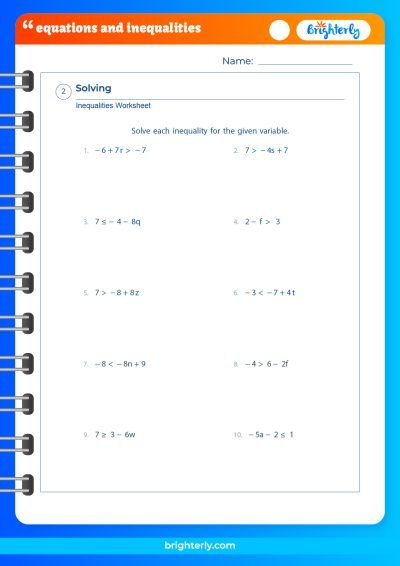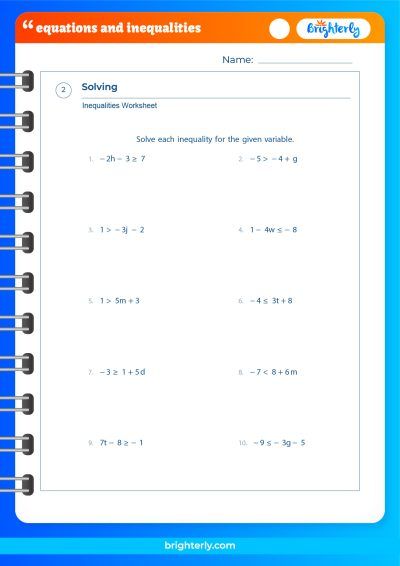Linear Equations – Formula, Definition With Examples
Updated on January 14, 2024
Welcome to Brighterly, where we make mathematics a fun and engaging journey for kids! Today, we are diving deep into the fascinating world of linear equations. These mathematical tools might seem basic, but they act as a cornerstone for many intricate mathematical principles, laying the foundation for algebra, calculus, and even data science. They are vital in our everyday lives, aiding in everything from budgeting our monthly expenses to even complex architectural designs. By the end of this post, you’ll gain a thorough understanding of linear equations, their definition, formula, properties, and even get to practice with some examples.
What Are Linear Equations?
Linear equations, at their most basic, represent a straight line when graphed. They are a staple in the world of mathematics and are introduced to students early in their education. These equations play a foundational role in various fields such as physics, economics, computer science, and more. While the concept may seem simple, mastering linear equations can open the door to understanding more complex mathematical principles.
They’re called ‘linear’ because each term is either a constant or the product of a constant and a single variable. Understanding how to work with linear equations provides an essential skillset for fields that heavily rely on mathematical modeling or data analysis.
Definition of Linear Equations
A linear equation is an equation between two variables that produces a straight line when plotted on a graph. The general form of a linear equation in two variables (x and y) is ax + by = c, where ‘a’, ‘b’, and ‘c’ are constants, and ‘a’ and ‘b’ are not both zero. The values that ‘x’ and ‘y’ can take, which satisfy this equation, are the coordinates of the points on the line representing the equation.
Formula for Linear Equations
Linear equations can be presented in multiple forms, the most common being the slope-intercept form, represented as y = mx + b. In this formula, ‘m’ represents the slope of the line, while ‘b’ is the y-intercept. The slope dictates the angle at which the line tilts either upwards or downwards, while the y-intercept is the point at which the line crosses the y-axis.
Properties of Linear Equations
A few distinctive properties of linear equations make them unique:
- The graph of any linear equation in two variables is a straight line.
- Every point on the line is a solution to the equation.
- Every solution of the equation is a point on the line.
Understanding these properties can facilitate comprehension of more complex mathematical concepts down the line.
How to Identify Linear Equations
A quick way to identify a linear equation is by its degree, which is the highest power of a variable. In a linear equation, the degree is always 1. Another tell-tale sign is the absence of products of variables, roots, or absolute value signs.
Understanding Coefficients and Constants in Linear Equations
In the equation y = mx + b, ‘m’ is the coefficient, and ‘b’ is the constant. The coefficient ‘m’ determines the line’s slope, and the constant ‘b’ specifies the y-intercept, the point where the line intersects the y-axis.
Graphical Representation of Linear Equations
The graphical representation of a linear equation forms a straight line. Plotting a linear equation involves finding various (x, y) points that satisfy the equation and connecting these points to create a straight line.
Solving Linear Equations
Solving linear equations is an integral part of mathematics. Solving an equation means finding the variable values that make the equation true. For linear equations, the solution can always be found using algebraic methods or graphically by finding the x-intercept of the graph.
Steps to Solve Linear Equations
Typically, to solve a linear equation, follow these steps:
- Simplify both sides of the equation by eliminating parentheses and combining like terms.
- Add or subtract quantities to obtain the unknown on one side and the numbers on the other.
- Multiply or divide each side of the equation by the same nonzero quantity to obtain a solution.
Applications of Linear Equations
Linear equations find extensive use in various fields, such as physics, engineering, computer graphics, economics, and more. They are used in modeling scenarios, predicting outcomes, and even in machine learning algorithms. Understanding linear equations is fundamental to tackling real-world problems.
Practice Problems on Linear Equations
To enhance your understanding and improve your skills with linear equations, we have compiled a list of practice problems below:
- Solve for ‘x’: 2x – 5 = 15
- Solve for ‘y’: 3y + 7 = 22
- If y = 4x + 3, find ‘y’ when ‘x’ is 5.
- If y = -2x + 7, find ‘x’ when ‘y’ is 3.
- Graph the equation y = 2x – 1. Identify the slope and y-intercept.
Solutions:
- Add 5 to both sides to get 2x = 20. Then divide both sides by 2 to solve for ‘x’. Hence, x = 10.
- Subtract 7 from both sides to get 3y = 15. Then divide both sides by 3 to solve for ‘y’. Hence, y = 5.
- Substitute 5 in place of ‘x’ in the equation to get y = 4*5 + 3 = 23.
- Substitute 3 in place of ‘y’ in the equation to get 3 = -2x + 7. Rearrange to 2x = 7 – 3 = 4. Hence, x = 4/2 = 2.
- The slope of the equation is 2, and the y-intercept is -1. To graph the equation, plot the y-intercept and then use the slope to find other points on the line.
Conclusion
And there you have it! We’ve taken a comprehensive tour through the world of linear equations. From understanding what they are to learning how to solve them and identify their properties, we hope you now have a solid grasp of these vital mathematical tools. Here at Brighterly, we believe that grasping such concepts can open up a wealth of opportunities, whether it’s helping with homework, preparing for tests, or even sparking an interest in a STEM career. Remember, like any skill, mastering linear equations requires consistent practice and a curiosity to learn. So, don’t shy away from practicing the problems we’ve provided or exploring even further!
Frequently Asked Questions on Linear Equations
What is the difference between a linear equation and a nonlinear equation?
A linear equation always represents a straight line when graphed, and its highest power is always 1. On the other hand, a nonlinear equation can represent a variety of forms such as parabolas, hyperbolas, circles, etc., and its degree can be 2 or more.
What is the slope in a linear equation?
The slope in a linear equation refers to ‘m’ in the slope-intercept form of the equation (y = mx + b). It represents the steepness of the line — a positive slope means the line is rising, and a negative slope means the line is falling.
What is a system of linear equations?
A system of linear equations is a set of two or more linear equations that all contain the same set of variables. A solution to the system is a set of values for the variables that satisfies all the equations simultaneously.
What are the applications of linear equations in daily life?
Linear equations are everywhere in daily life. They can help us solve problems involving distance, time, and speed, calculate budgeting and finance-related matters, make predictions in business, and even in programming and creating algorithms in the field of computer science.
Can linear equations have fractions or decimal coefficients?
Yes, linear equations can have fractions or decimal coefficients. Regardless of whether the coefficients are whole numbers, fractions, or decimals, the equation can still be considered linear as long as it represents a straight line when graphed, and its degree is 1.






